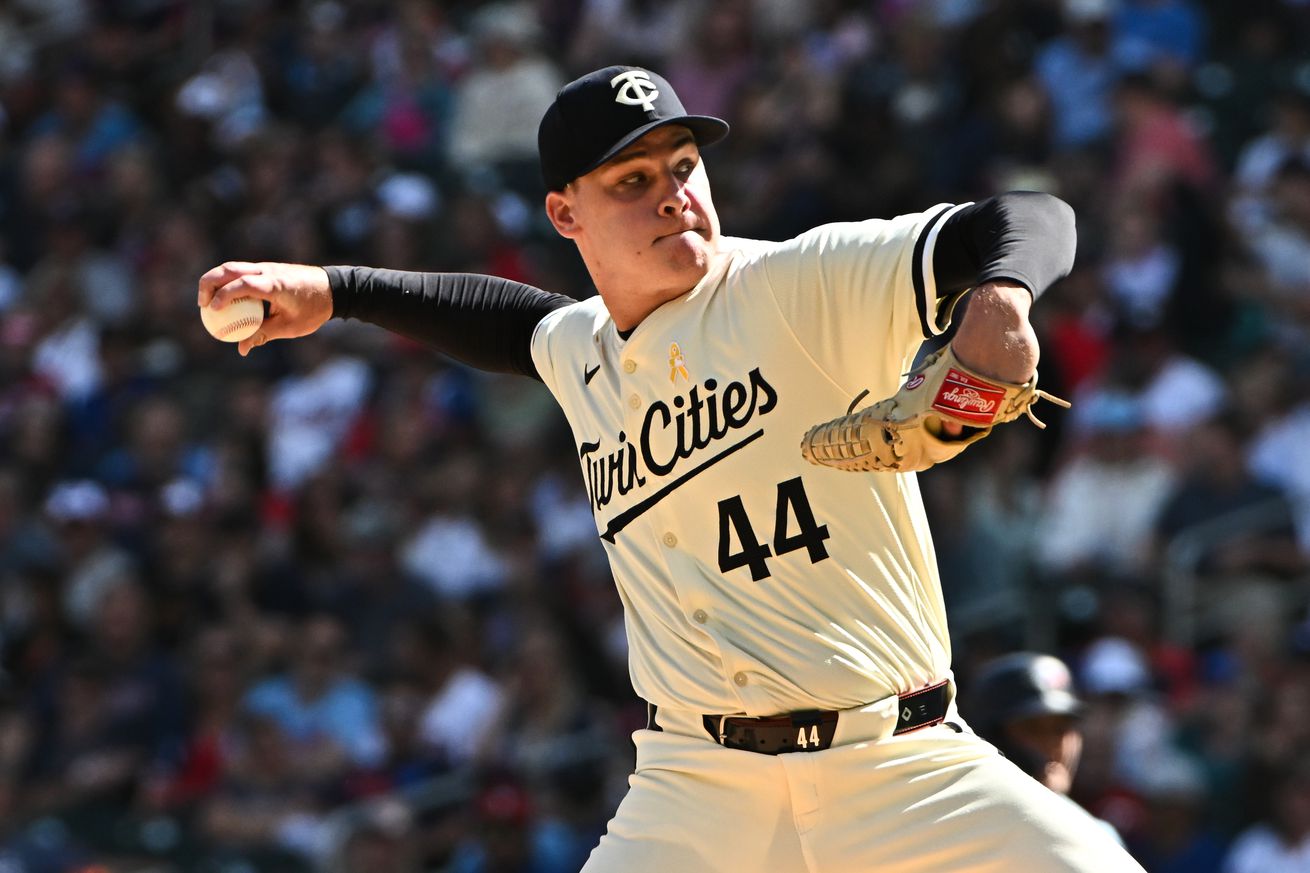
Better velocity, a new primary pitch, and better command of it all unlocked a new level
Ok, Twins fans. Raise your hand if you predicted Cole Sands would lead all Minnesota relievers in innings pitched in 2024. Anyone? No? Ok, now raise your hand if you would have expected Cole Sands leading the club in relief innings pitched to be a good thing. Still nobody?
I’m here to tell you that Cole Sands led the Twins in relief innings and finished second on the club in appearances last season. And, I want you to know that those were unequivocally good things because of how Sands performed.
He was not the same pitcher that he had been in prior years.
Over 71 and ⅓ innings and 62 appearances, he worked to a 3.28 ERA and 2.63 FIP. He averaged more than a strikeout per inning. He quickly became one of Rocco Baldelli’s most trusted relievers. The average leverage of his appearances was 1.07. While that ranked just 8th among Twins relievers, Sands provided the third-most win probability added once adjusted for leverage (0.76 WPA/LI).
Cole Sands, 3Ks in the 7th. pic.twitter.com/cicLDVWoaZ
— Rob Friedman (@PitchingNinja) June 20, 2024
Before 2024, Sands — a 2018 fifth-round draft choice from Florida State University — had been viewed as a potential back-end starter prospect and made his first entry to the majors as an up-and-down long-reliever and spot-starter.
In 52 and ⅓ career MLB innings, he had a 4.99 ERA and a 5.06 FIP that came with too much contact and too many walks in almost exclusively low-leverage appearances.
Sands had to battle in Spring Training to make the 2024 Opening Day roster, and may not have succeeded if not for injuries to Jhoan Duran and Justin Topa creating an opportunity.
Sands took that opening and ran with it, thanks to some key developments in his stuff and approach.
Velocity is King
A significant part of the explanation for Sands’ breakout is present in this chart:
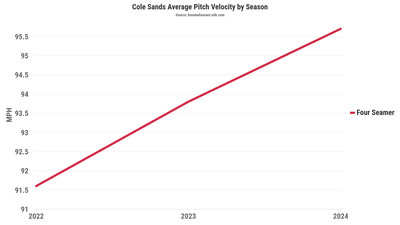
Sands has steadily increased his velocity since his MLB debut in 2022. That year, he averaged 91.6 mph on his four-seamer, which was 17th percentile fastball velocity. Last year, he averaged 95.7 mph, which was in the 71st percentile.
The additional velocity is the result of Sands doing some serious offseason mechanical and strength work with Tread Athletics, which is detailed well in this short video clip:
Twins RHP Cole Sands joined us during the ’22/’23 off-season after averaging 91.6 T94.8 on his FB.
Cole put in a ton of work the last 2 off-season and is now sitting his previous peaks (95.1 mph) topping 97.3 mph and has improved the rest of his arsenal
PC: @turnergivens pic.twitter.com/zN1T2oEGzj— Tread Athletics (@TreadHQ) June 20, 2024
It’s easy to see in the clip how Sands’ movement earlier in his career was not maximizing his potential. His pitching motion became more fluid and athletic, illustrating how he’s cleaned up the order of operations in his mechanics to turn the force he creates into velocity more efficiently. His motion at the end of the clips looks much more like one connected chain of movements instead of a series of disparate steps one after the other.
One key element is focusing on generating power from the pitching rubber through the heel of his right foot instead of his toe. This helps pitchers activate more of their stronger glute muscles to create their power instead of their quads. The Twins have had this as a point of emphasis in their biomechanics coaching for several years, and it is foundational to Sands moving much faster down the mound.
This matters because faster fastballs are harder to hit. We know this intuitively and objectively. I did some analysis early last season that showed each additional tick of four-seam velocity cut off an average of 14 points of wOBA allowed. That is mostly because velocity suppresses slugging. It is very difficult to hit higher velocity for power.
Importantly, 95 mph is the threshold where four-seamers, at the league level, become net positive pitches.
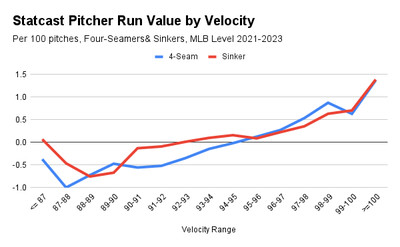
Data from Baseball Savant
That tipping point is a significant part of the context for Sands’ development story.
In his rookie year, when none of Sands’ four-seamers touched 95 mph, opposing hitters produced a .336 wOBA and whiffed on 20.7% of their swings against the pitch. Last season, when 251 (about 77%) of Sands’ four-seamers were 95 mph or better, they were limited to .242 wOBA and whiffed on 31.2% of their hacks against it.
Angle Matters, Too
It wasn’t only the velocity gains that made a difference. Those mechanical developments also extended to Sands’ arm angle, which has moved higher since his MLB debut:
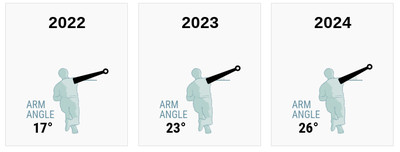
Graphic courtesy of Baseball Savant
Sands has always operated from a relatively low arm slot, which has given his four-seamer more of a horizontal movement profile.
As he’s pushed that angle higher, his four-seamer has picked up about an inch and a half more vertical movement, while maintaining all of its horizontal break. That’s also been true for his cutter (more on that in a second) — Sands’ cutter averaged 84.3 mph with 3.2 inches of vertical break as a rookie but was up to 90.8 mph and 8.2 inches of vertical movement last season. You can see those shifts here:

That extra vertical movement on both pitches, when combined with the extra velocity, is a big part of why Sands was able to miss more bats and post a 29.1% strikeout rate last year, which was in the 88th percentile and about 9 points above his previous career mark.
Fewer Fastballs are More
Although Sands was now operating with increased four-seamer velocity and a more advantageous movement profile, he also made a conscious shift to feature that pitch less often, something that has been a league-wide trend for more than a decade.
Where almost half (48.8%) of Sands’ pitches were four-seamers during his rookie season, only 28.2% were last year. In their place was the revamped cutter that had previously made up about 7% of his offerings.
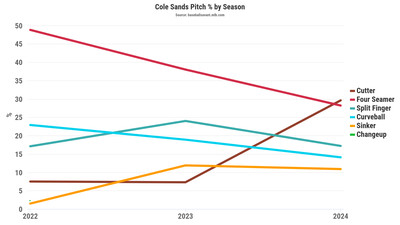
The motivation for switching some four-seamers to cutters likely was about finding better ways to work inside the strike zone.
In 2023, Sands allowed opposing hitters to make contact on 89.6% of their swings against his pitches located in the strike zone, which was well above the 82% league average. He allowed a .545 slugging percentage and a .355 wOBA inside the strike zone, and opposing hitters produced a barrel on 14% of their batted balls in play.
A lot of that damage stemmed from the fact that Sands didn’t draw enough swings and misses in the zone. Where the league’s pitchers got a whiff on 18.9% of their four-seamers in the strike zone, Sands did so only 12.7% of the time. Sands used a sinker about 11% of the time, but his sinker strikes only grabbed a whiff on 5.9% of swings against them, about half the 11% league average.
Last season, when he featured the cutter — which had a 28.6% in-zone whiff rate in limited use in 2023 — more and the newly powerful four-seamer, Sands was able to draw an above-average 19.9% whiff rate and hold opponents to .369 slugging and .264 wOBA inside the strike zone.
Without needing to fear being hit hard in the zone quite so much, and with mechanics he was able to repeat more consistently, Sands was also more aggressive in attacking the strike zone.
While he only threw a few more pitches in the zone overall last season (51%, up from 50.6%), he threw first-pitch strikes more often (65.1%, up from 59.6%) and was ahead in the ball-strike count for 30.9% of his pitches (up from 29.5%). As a result, he chopped his walk rate down to an outstanding 4.1% (97th percentile).
Better stuff, a smart approach, and a refined ability to consistently execute was the story of Cole Sands in 2024. With these developments in hand and a strong full season under his belt, Sands appears locked in to the Twins’ middle relief mix against next season.
Relief performance is notoriously fickle, but Sands’ improvements are the kind to believe in. It’s reasonable to expect that he can provide a similar level of production going forward.
John writes for Twinkie Town, Twins Daily, and Pitcher List with an emphasis on analysis. He is a lifelong Twins fan and former college pitcher. Follow him on Twitter @JohnFoley_21.
